Will the Tip of a Squirrel Tail Grow Back
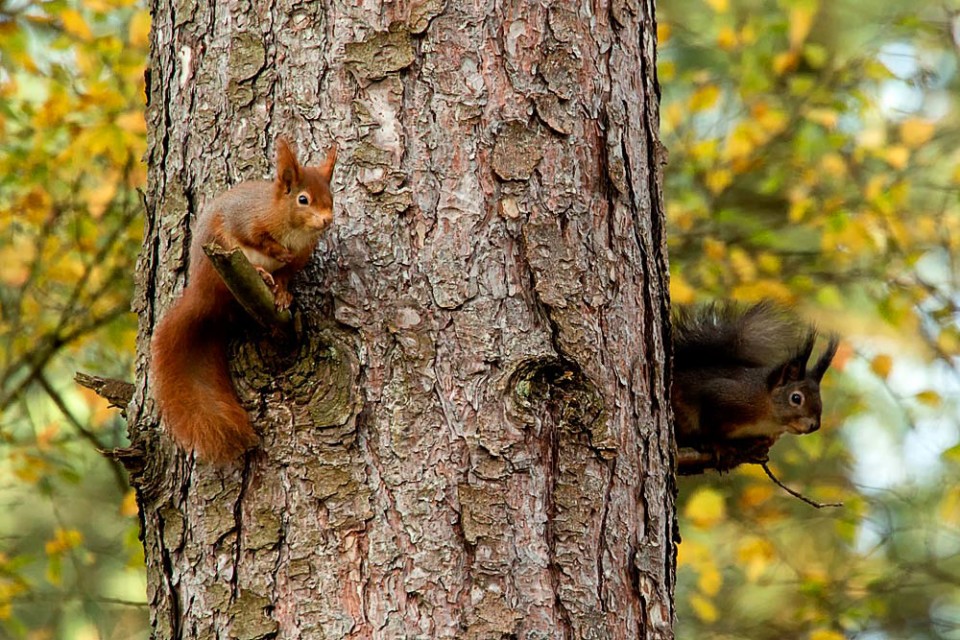
Red and Grey squirrels are generally simple to separate based on coat colour. Coat colour in squirrels is, however, highly variable, particularly among Red squirrels. Indeed, many of the 40 proposed Red subspecies are thought to actually be colour variants. Red squirrel fur can range from jet black to a dull yellowy-brown (often referred to as "buff"), covering most shades of red and brown in between, and the pelage colour varies according to location, season and age (adults tend to be lighter than juveniles).
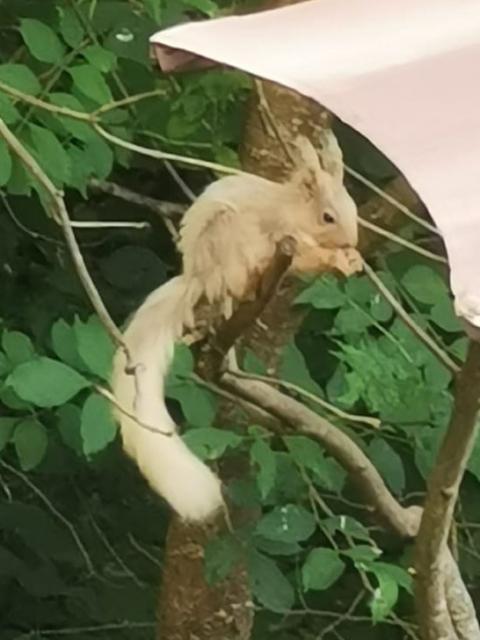
Albino and white Reds are rare throughout their range, while melanistic (black) Reds are common in some regions, such as Denmark and parts of continental Europe. In a 1993 paper to the journal Mitteilungen aus unserer Säugetierwelt, Rainer Allgöwer reported that about half the Reds in his study area of Baden-Württemberg in south-west Germany were red, while 23% were dark brown and 27% were black. In the UK some populations exhibit very dark pelage, particularly those in Formby and Ainsdale, but I am aware of only a single, unconfirmed, population of truly melanistic animals near St Andrews in Scotland. An article in The Telegraph in October 2012 reported the presence of "brunette" Reds in Britain, which appear to be melanistic squirrels with a reddish tinge/sheen. Most recently, in February 2018, a single black Red was reported near Yaverland, just north of Sandown on the Isle of Wight, although at the time of writing the record remains unconfirmed.
Craig Shuttleworth of the Red Squirrel Survival Trust tells me that he receives reports of white squirrels from time to time, the last in northern England during 2015, but that the details are usually vague. The RSST had a leucistic Red with them between 2004 and 2006 but, according to Dr Shuttleworth, it was never released as part of the reintroduction project. At the time of writing (November 2019), I'm only aware of three confirmed accounts of wild white Red squirrels from the UK: an albino Red reported along the now disused Freshwater-Yarmouth railway line on the Isle of Wight in 2017; a white animal photographed in Royal Deeside, north east Scotland, during November 2019; and a non-albino white individual photographed by Chris Eddington in his garden near Dunkeld in Scotland during late April 2020.
Grey squirrels are typically grey-backed, with grey tails and a white (or significantly lighter) underside and flanks that vary from grey to a dusky red. Indeed, some Greys develop a decidedly red appearance. Melanistic and albino Greys are nationally rare, although they may be locally common. White individuals (not necessarily albino) seem rather common in the south of Britain and parts of the USA—white (non-albino) squirrels account for about 23% of S. carolinensis in the city of Brevard North Carolina—while black squirrels are, since their appearance in Hertfordshire in 1912, increasingly common in parts of England (e.g. Cambridgeshire, Hertfordshire, and Bedfordshire), where they may equal or even out-number their grey morphs. Genetic data from scientists in Cambridge show the exact same gene mutation in black Greys from the UK and the USA (Massachusetts, Virginia, and British Columbia), implying that the melanistic animals in Britain today are descendants of black animals introduced from North America.
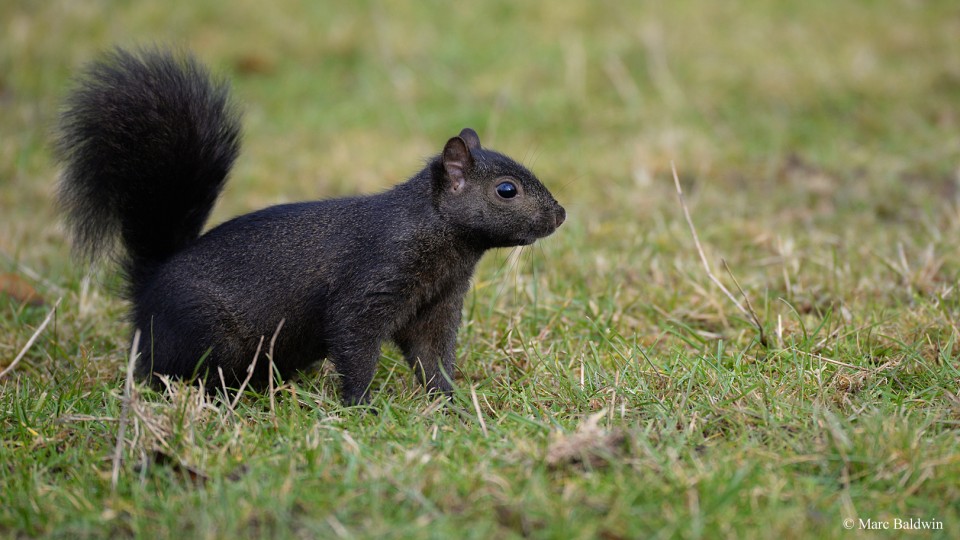
Between 2012 and 2014 the Black Squirrel Project received 6,100 reports of black Greys in the UK that indicate they have now spread into south west England, Wales and southern Scotland. (There is some suggestion that there may be as many as 25,000 melanistic Greys in Britain, implying about 1 in 330 is black, but nobody really knows; all we can say is that they appear to be spreading.) Helen McRobie at Anglia Ruskin University in Cambridge demonstrated that melanism in Greys is a genetic condition caused by a shortening of the melanocortin 1 receptor (MC1R) by 24 base pairs. Of particular note are their more recent data, published in BMC Evolutionary Biology in 2019, which identified exactly the same deletion in melanistic Fox squirrels (Sciurus niger), implying that Greys picked up the mutation by interbreding with Fox squirrels at some point in their evolutionary history. McRobie and her colleagues have also found that this genetic difference is incompletely dominant meaning squirrels can be either grey, black or black-brown, according to whether the squirrel has two normal-length MC1Rs, two short receptors or one normal and one short receptor. Interestingly, the same does not appear to be the case for Reds, in which we think melanism is much more complex, resulting from mutations in a suite of genes.
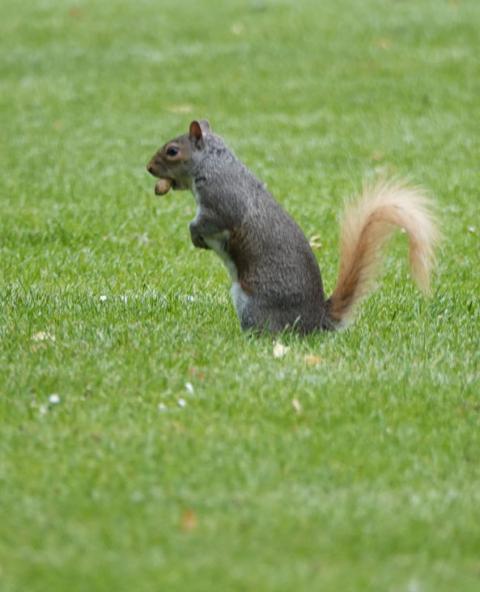
Despite the differences in colouration, black and white morphs are not separate species; they are merely a colour variant of the wild-type (normal) coloured squirrels reflecting their genetic composition. Being under genetic control, fascinating colour aberrations appear in squirrels from time to time, including 'red', 'frosty' and piebald Grey morphs. Likewise, in his 2016 book The Nature of Autumn, nature writer and poet Jim Crumley mentions "a stallion of a beast" of a Red squirrel feeding in an oak tree at Glen Finglas in the Trossachs, Scotland. Crumley described the animal as sporting traditional red fur "strikingly dusted in patches of a smoky, purplish black", a band of which also ran along its back and across the top of its head, extending down onto its face - its tail was "almost jet black". Colour abberations are seemingly very rare in both species and I would be very interested to hear from anyone who has seen a similar colouration. Squirrel coat colouration, and the mechanisms behind it, is discussed in greater detail in the associated QA.
Albino Greys are reported from time-to-time and seem to do better in the wild than many other albino mammals. Typically, albino animals don't survive long in the wild and this is often put down to a lack of camouflaging ability, which makes them easy targets for predators. Work by Jona Esteve at the University of Barcelona and Glen Jeffrey at University College London published in Vision Research back in 1998, however, suggests that retinal development may also be a crucial factor. Albino mammals generally exhibit a noticeably under-developed retina, with a fewer rod cells and central ganglion cell density about 25% lower than in pigmented animals.
When Esteve and Jeffrey studied the retinas of two albino Grey squirrels and compared them with those from normally-pigmented individuals, they found that the albinos showed only about a 5% reduction in central ganglion cell density, implying that albino squirrels don't suffer the same decline in visual acuity that other albino mammals do. Thus, their relative immunity to retinal deficits may help to explain why squirrels are the only albino mammal to show consistently successful survival in the wild and seem to have the same mastery of the treetops as normally-pigmented animals.
Among the Greys, silvery (frosted), erythristic (reddish) and cinnamon morphs have also been reported (see image below). The cinnamon morph has a gingery head with an orange stripe across the shoulders and down the back, extending along the tail; the flanks are grey but the feet orange. This appears to be a relatively recently reported morph, but is already becoming increasingly common in the New York State area, with data from the Central Park Squirrel Census collected in 2018 suggesting that it accounts for about 13% of the park's squirrel population, nearly four times the number of black morphs.
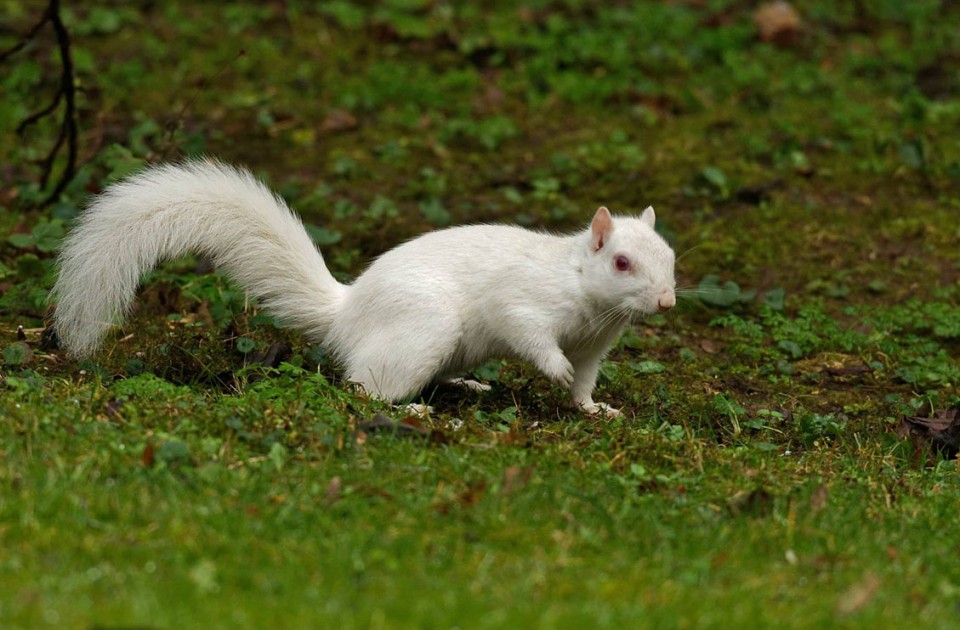
In addition to colour morphs, some Red squirrel populations, particularly in the UK, exhibit a bleaching (i.e. lightening) of the tail that is particularly noticeable in their summer pelage. Indeed, a blonde tail is often considered a trait of the British subspecies,leucourus. Peter Trimming's observations in Cumbria suggest that colour varies with moult both during and across years, with a strong individual component. Trimming has noted, for example, how one of the females ("Caroline") in his study population in Eskdale often develops a blonde tail in early June, while other members of the same population "go blonde" from April.
Moulting
Colour and appearance of both species may change in accordance with moults. Both Reds and Greys moult biannually—once in the spring (March to July) and again in late autumn (September to December)—although the ear-tufts (in Reds) and tail hairs are only replaced once a year, during the summer. In late spring or early summer, the tail of Red squirrels is thinner and, in some populations, can be almost white; the rest of the coat tends to be either a chestnut brown or orangey-red colour, with very small (typically absent) ear tufts. In both species, the spring moult starts on the head and proceeds backwards, while the autumn moult starts at the base of the tail and progresses forwards up the back, down the flanks to the legs and finally the stomach.

The winter coat is complete and at its thickest by December, at which point the ear tufts stop growing – ear tufts can reach 3cm (1 inch) in length in mature individuals. There are some data to suggest that poor body condition may delay the mould in Red squirrels and that males may start moulting earlier than, and experience a protracted moult compared to, females. Females tend to moult after the spring litter is born and, according to Stefan Bosch and Peter Lurz in their 2012 book The Eurasian Red Squirrel, may not begin the second moult until the autumn litter are weaned.
The influence of habitat
Finally, coat colour may have survival advantages in some habitats and/or seasons. While studying for his MSc thesis at Toronto's York University in the early 1970s, Douglas Farquhar measured oxygen consumption in three colour morphs of Grey squirrel in southern Ontario and suggested that melanistic animals were more energy efficient than intermediate and grey morphs. In a paper to the Canadian Journal of Zoology in 1979, the late University of Guelph zoologist Stuart Innes and his colleague David Lavigne reanalysed Farquhar's data and, when they accounted for the moulting phase that Farquhar had overlooked, found no significant difference between the colour morphs.
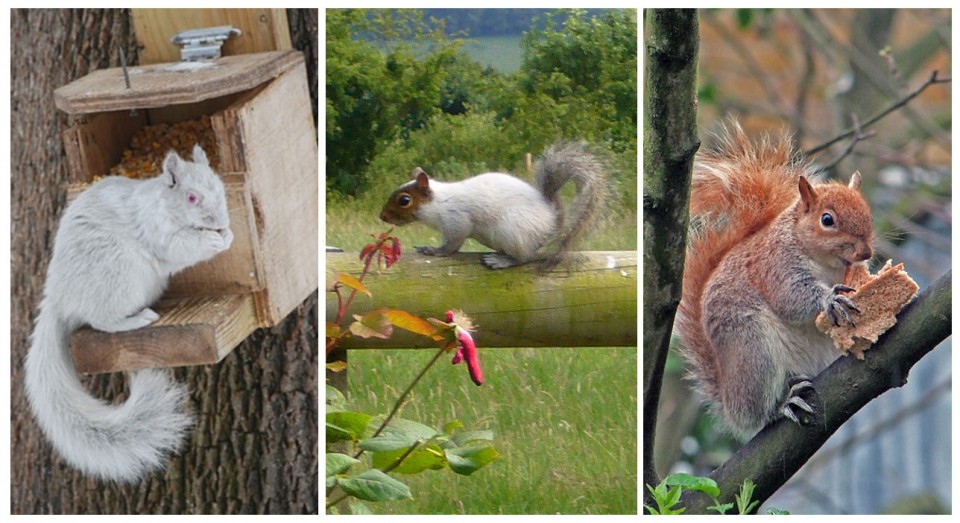
When they studied the response of different coloured squirrels kept in their labs Innes and Lavigne did, however, find melanistic Greys lost less body heat and had a lower basal metabolic rate than grey morphs over a temperature range from -20C to 25C (-4 to 77F). One of the squirrels was found to be hypothermic at -20C, but recovered when warmed up to 20C (68F) without any obvious ill effects or tissue damage, suggesting a level of extreme cold tolerance in this species. The core temperature of winter-acclimated melanistic squirrels was 37C (99F), while grey morphs were slightly higher at 39C (102F) – this result was not statistically significant, but may none the less hint at an adaptation.
Similarly, a fascinating study published in the journal Mammalia during 2004 by a team of biologists working on Red squirrels in northern Italy suggests that coat colour may affect survival. Luc Wauters, Massimiliano Zaninetti and Guido Tosi at the University of Insubria and Sandro Bertolino of Turin University report that so-called "red morphs" were most common in the mixed woodlands of the Upper Po-plain, while "black morphs" were the most numerous individuals they trapped in the Alps (esp. western and central Alps) – "brown morphs" were rare. While juvenile survival did not alter according to coat colour, the biologists found that the frequency of black morphs was positively correlated with high proportions of fir and spruce in the forests.
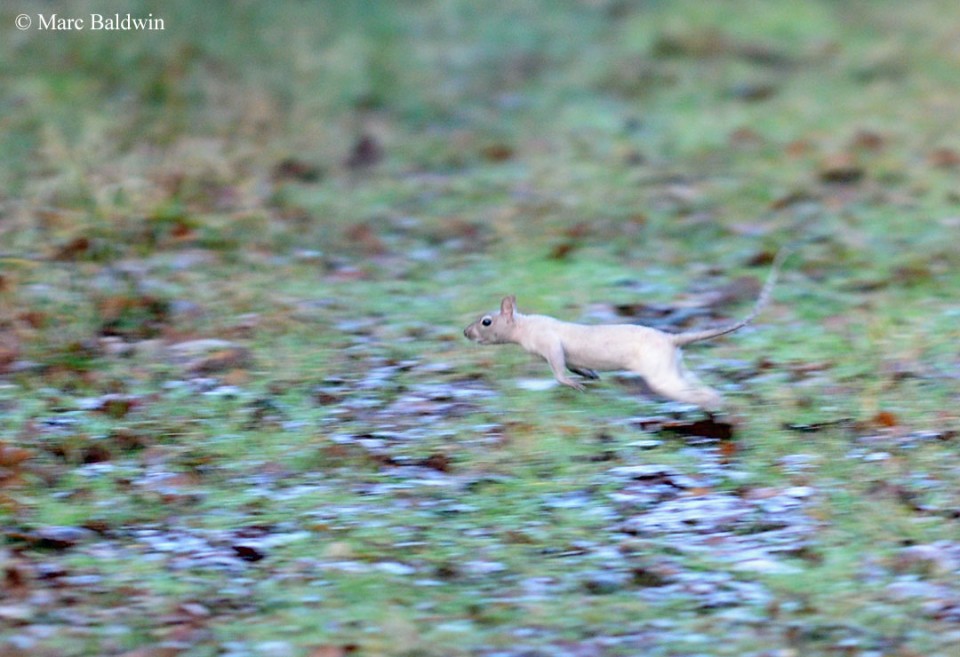
Previous research (during the 1960s and 70s) found that black morphs have a longer and denser undercoat than red ones, and completely black Greys were more tolerant to cold (specifically 18% less heat loss and 11% higher non-shivering thermogenesis capacity) and had a lower metabolic rate (BMR 20% lower) than grey morphs when temperatures dropped below -10C (14F).
Wauters and his team concluded that while elevation alone could not explain the variations they observed in colour morphs, their results did support the "Cryptic Coloration Hypothesis", which suggests that the presence of dark fur in dense conifer forests may provide a selective survival advantage. In other words, having black fur in a generally dark and gloomy conifer forest might make it less likely that a predator, will nab you. The Red morphs were better camouflaged—the red fur blending into light-shade patterns among leaves—in the mixed broadleaf canopies than in conifers. Moreover, the Red squirrels always retained a white venter (underside), which produced a counter-shading effect and helped them further blend into their surroundings.
Finally, in their assessment of behavioural differences between melanistic and all other colour morphs in New York's Central Park, Lee Cronk and Ryne Palombit at Rutgers University observed that black morphs were most common in sections of the park with the highest squirrel densities. In their paper to Acta Ethologica in 2021, they note that such a finding is often indicative of increased aggression, but instead raise the interesting consideration that:
"It is possible that life in such hectares might be more stressful (socially and/or energetically). Given that research with other species has found an association between melanism and an ability to better resist stress, the possibility that the same might be true for eastern gray squirrels would be worth exploring in future research."
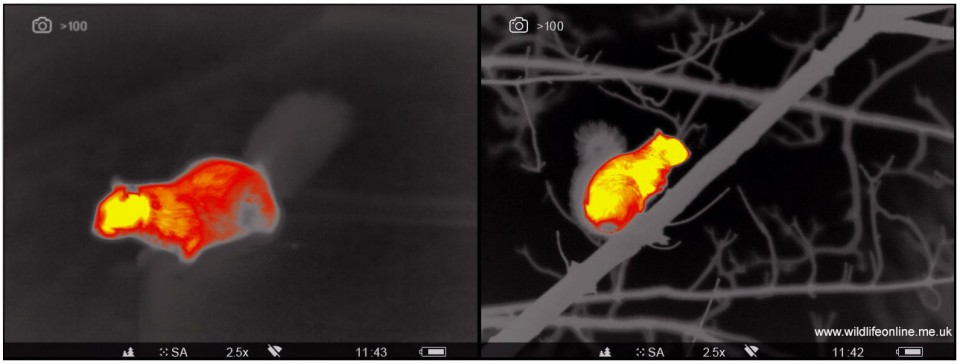
Hair types & grooming
In common with most mammals, squirrels have a dual-layered coat: short, fine underfur serves to trap air and insulate the squirrel, while longer, thicker guard hairs provide protection from water and wind. The guard hairs of Reds are approximately 20mm (0.8 in.), while those of Greys are slightly shorter, ca. 15mm (0.60 in.). Tail hairs of both species are considerably longer, typically 30-40mm but sometimes reaching 45mm (1.2-1.7 in.).
Squirrels spend a significant amount of their time grooming, which follows a distinct sequence of events. The squirrel will start by grooming its head and forepaws before it moves on to groom its body. After body grooming is complete there is a period of hind leg scratching and hind foot licking. Finally, the squirrel will groom its tail. Grooming starts when the squirrel is about one month old.
Will the Tip of a Squirrel Tail Grow Back
Source: https://www.wildlifeonline.me.uk/animals/article/squirrel-fur-colour-characteristics
0 Response to "Will the Tip of a Squirrel Tail Grow Back"
Post a Comment